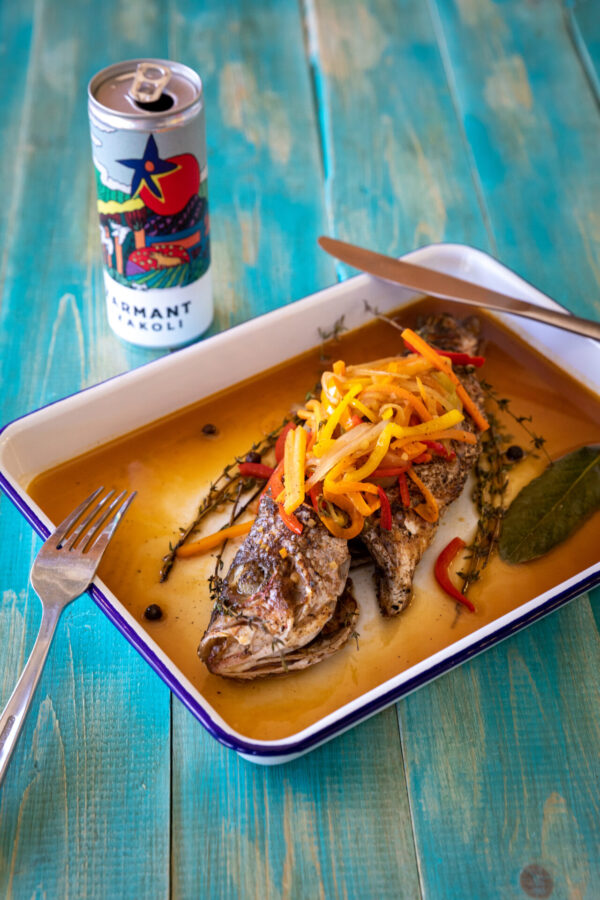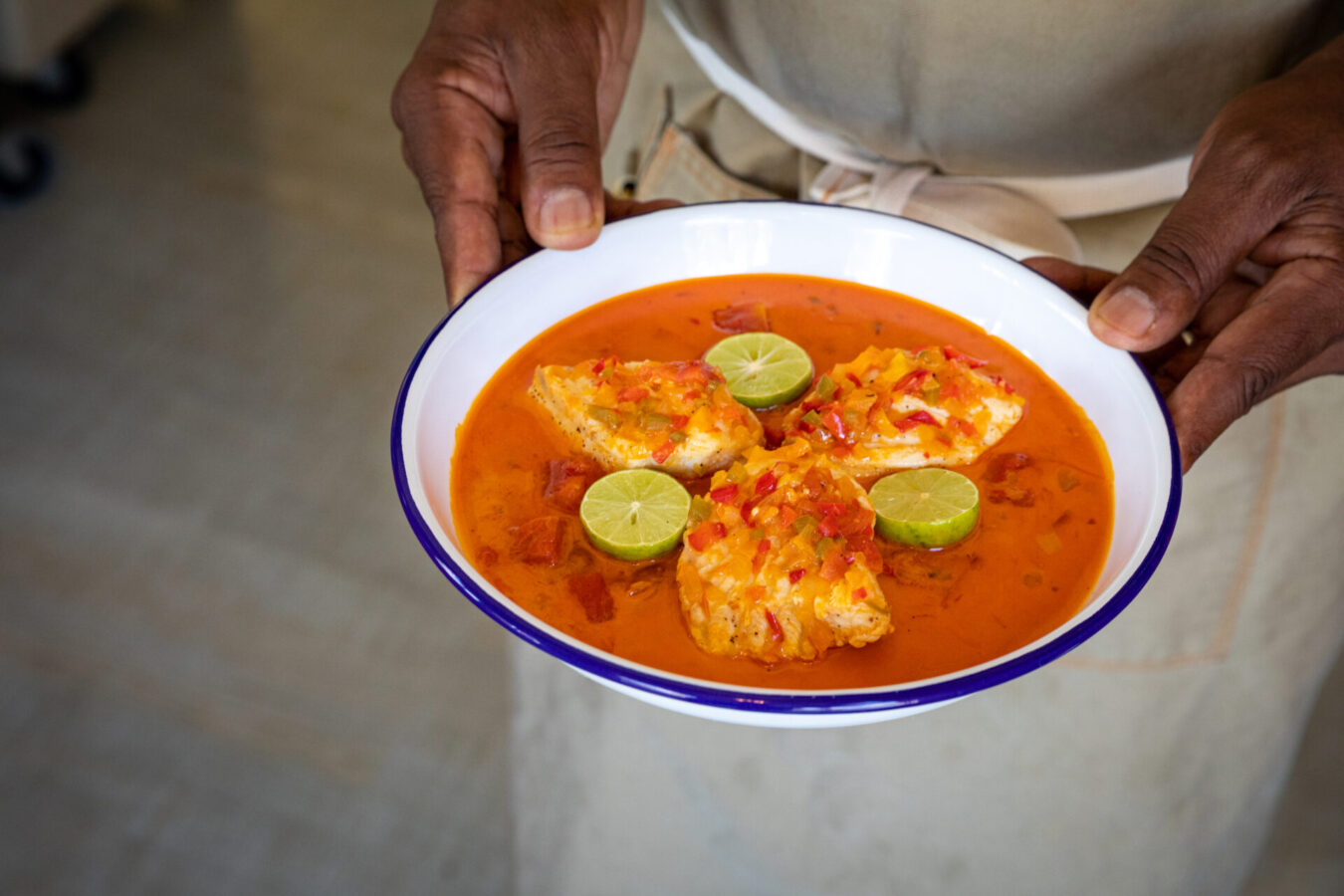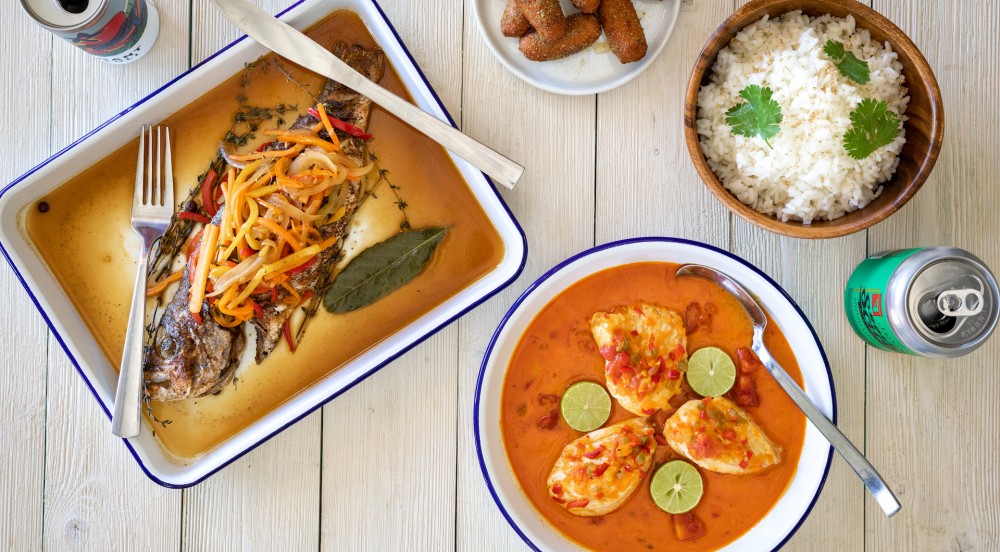Chef Moore focuses purely on the food inspired by his native Carolina coast.
Chef Ricky Moore does not play games when it comes to his passion for seafood. The self-professed "evangelist of North Carolina seafood" and esteemed James Beard Foundation Finalist for “Best Chef Southeast” is dedicated to putting fresh, local fish and shellfish at the heart of all his dishes. His popular ‘fish shack’ style restaurant Saltbox Seafood Joint®, located in Durham, North Carolina, is beloved by locals and critics for its elevated, seasonal menu that changes daily based on the local catch. It was even named “Best New Restaurant” by The News & Observer. Today, the Saltbox Seafood Joint® Cookbook author speaks to EBONY, sharing his guidelines for scoring the freshest, seasonal seafood and offers two mouthwatering, fish-forward recipes to try at home.

Tips for navigating the fish market:
- "Source from the best place you can find for fresh, quality fish whether that’s a fish market or a fish counter inside an upscale grocery like a Whole Foods or Wegmans. Once you find your source, build a relationship with the person behind the counter" shares Chef Moore. "Ask them which fish are fresh, which have been frozen and talk to them about what sorts of fish you like–light and mild or more full-flavored? Then ask them what different varieties are available based on your preferences."
- And once you’ve identified your preferences here's how to determine the freshness. He explains, "For whole fish you want to see clear eyes, gills that are crimson red, and flesh that feels firm to the touch. For filets of steaks, the only tool to use is your nose; it should smell like ocean freshness (or nothing at all)."
- Chef Moore details, "The best bang for your buck is to buy whole fish and cook it whole like my recipe for grilled escovitch snapper or butcher it yourself. The minute a fishmonger takes a knife to a fish, the price goes up. If buying to cook and serve whole, make sure to ask the fishmonger to scale and gut (in the business we call that “S & G”) and also remove the gills!"
- "Another tip for value is to ask about non-uniform chunks or pieces (like you would use in the Moqueca stew). Most consumers want uniform steaks and fillets, so the end cuts are ften leftover and cost less. They are perfectly good/fresh; they are just not all the same shape/size" he shares.
Recipes:
Chef Moore explains the significance of the recipes below. He says, "I've chosen to feature dishes that I’ve eaten in the regions where they originated and experienced them prepared by someone’s native hands (and that I’ve also made myself). These dishes speak to the global influence African food has had on our food culture in the Americas, not just the United States. At Saltbox Seafood Joint, we celebrate the fish and seafood of the North Carolina coast so it was important to stay within those boundaries and honor these dishes the Saltbox Seafood way." Enjoy!
Grilled Escovitch Red Snapper with Coconut Pickled Vegetables

Serves 4
Ingredients:
2 each 1.5 lb whole red snapper cleaned, scaled and scored
1 lemon
Salt and pepper
1/4 cup vegetable oil
1 bay leaf
1 teaspoon minced garlic (about 2 garlic cloves)
½ teaspoon grated fresh ginger
1 yellow medium onion cut into julienne (thin strips)
1 medium carrot cut into julienne (thin strips)
½ red bell pepper cut into julienne (thin strips)
½ yellow bell pepper cut into julienne (thin strips)
3 sprigs thyme
1 Scotch bonnet pepper pierced (or ½ teaspoon cayenne pepper)
½ teaspoon Jamaican ground allspice
1 tablespoon honey
1 teaspoon Worcestershire sauce
¾ cup coconut vinegar (white vinegar or apple cider can be used)
Directions:
Preheat the oven to 375 degrees.
Rinse fish; rub with lemon, seasoned with salt and pepper and set aside.
Brush a large grill pan with 1 tablespoon of oil and heat over medium heat, until very hot and you can see a whisper of smoke coming off the grill pan. At this point, add the fish and sear for about 5-7 minutes on each side until the skin is crispy on both sides. Put fish in the oven and cook for another 7 minutes or until the fish is cooked through. Remove fish, set aside and keep warm.
In a large saute pan add the remaining 3 tablespoons of oil. Add, bay leaf, garlic and ginger, stir-fry for about a minute making sure the garlic does not burn.
Then add onion, bell peppers, carrots, thyme sprigs, scotch bonnet, sugar, Worcestershire sauce, allspice and continue stirring for about 2-3 minutes. Add vinegar, mix and adjust salt and pepper according to preference. Let it simmer for about 2 more minutes.
Place fish on a plate and spoon vegetables and the vinegar sauce all over the fish and serve.
Recipe for MOQUECA: an Afro-Brazilian Style Fish Stew with Rice & Toasted Benne Seeds

Serves 6
Fish preparation:
1-1.5 pounds firm white fish (Grouper, Shark, Sea Bass, Swordfish) cut into large chunks
½ teaspoon Kosher salt
1 lime, zested and juiced
Stewing sauce ingredients:
3 tablespoons Dend, also called red palm oil (you can substitute coconut oil but technically it won’t be a traditional moqueca without red palm oil which is one of its defining ingredients)
1 Spanish yellow onion- finely diced
1/2 teaspoon Kosher salt
1 cup carrot, diced
1 red bell pepper, diced
4 garlic cloves, rough chopped
1/2 jalapeno, finely diced
1 tablespoon tomato paste
2 teaspoons smoked paprika
1 teaspoon ground cumin
1 cup fish or chicken stock
1.5 cups diced tomatoes (preferably fresh)
1 14-ounce can coconut milk (liquid and solids)
½ cup chopped cilantro (you can substitute scallions or Italian parsley)
Squeeze of lime
Toasted Benne seeds as needed
Directions:
Rinse and pat dry the fish and cut into 2 inch pieces. Place in a bowl. Add salt, zest from half the lime and 1 tablespoon lime juice. Massage lightly to coat all pieces well. Set aside.
In a large saute pan, heat the Dende oil (or coconut oil) over medium high heat. Add onion and salt, and sauté 2-3 minutes. Turn heat down to medium, add carrot, bell pepper, garlic and jalapeno and cook for 4-5 more minutes.
Add tomato paste, spices and stock. Mix and bring to a simmer and add tomatoes. Cover and simmer gently on medium low for 5 minutes or until carrots are tender.
Add the coconut milk and taste and add more salt if necessary. Nestle the fish in the stew and simmer gently until it’s cooked through, about 4-6 minutes. Do not stir because it will break up the fish; rather, spoon the flavorful coconut broth over the fish and cook until desired doneness or longer for thicker pieces. (You can also finish this in a 350F oven).
Taste and adjust salt and squeeze with lime. Serve with rice, sprinkle with cilantro, squeeze of lime and Benne seeds.













